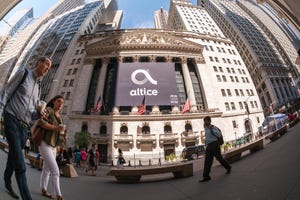
With their addiction to Russian gas, Germans risk communication blackouts this winter as their smartphone batteries run dry, even if mobile networks continue to whirr amid the energy crunch. But the country's newest operator will remain quiet for entirely different reasons. Under the terms of its mobile license, 1&1 was supposed to have installed at least 1,000 5G antenna sites by Silvester, as the Germans call New Year's Eve. Blaming its main antenna site partner for delays, it will miss the regulatory target and does not expect to have those sites up and running until summer 2023, it said in a little-noticed statement issued at the end of last week.
The delay of roughly six months is hardly insignificant and will prompt observers to ask if the hold-up is about standard supply bottlenecks or more specific technical difficulties. Together with Dish in the US and Rakuten in Japan, 1&1 is part of a trio of companies deploying open RAN. Where operators would normally buy all the components and software for any mobile site from one vendor's system, open RAN should – in theory – support combinations of different suppliers, thanks to new interfaces. The networks all three are building represent a radical departure in other ways, too, taking advantage of the latest software and Internet technologies as opposed to standard telecom fare.
1&1 has given responsibility for the rollout of its network to Rakuten Symphony, a telco-facing part of the Japanese firm touting software and system integration expertise. But the supplier blamed for delays is described as a "buildout partner" – unnamed in 1&1's brief statement – under contract for approximately two thirds of the 1,000 antenna sites. While two other partners are "delivering according to contract," the main one has failed to boost the speed of its rollout, said 1&1. Last week, the supplier in question apparently told 1&1 the hold-up could last months.
Figure 1: Share price of United Internet, 1&1's parent, in the last year ( euro )  (Source: Google Finance)
(Source: Google Finance)
Does 1&1 mean NEC? While 1&1 has been secretive about the identity of component suppliers, Rakuten recently outed the Japanese kit maker as a provider of 5G remote radio heads for the German rollout. Rakuten is relying heavily on NEC for its own deployment in Japan, ensuring its RAN software – which it gained with last year's acquisition of a US software developer called Altiostar – can harmonize with NEC's 5G equipment. NEC had not responded to an out-of-hours request for comment at the time of publication.
NEC, however, does not appear to have technical problems with Rakuten in Japan. It also ranked as one of the top three vendors of open RAN equipment globally for the first six months of this year, according to market research firm Dell'Oro, along with Samsung and Fujitsu. Its 5G sales last year rose 37%, to 57 billion Japanese yen (US$400 million), according to slides NEC recently shared with analysts, and it is targeting revenues of JPY190 billion ($1.3 billion) in 2025.
Disadvantage towers
1&1 could, however, be alluding to a site provider or tower company, rather than a manufacturer. Last December, it signed a contract with Vantage Towers, a subsidiary of Vodafone, to cover "the renting of Vantage's existing antenna locations and the installation of 1&1's high-performance antennas by Vantage," said 1&1 in its last earnings report. Delays could, then, refer to the job of antenna installation by Vantage or another provider. Intriguingly, 1&1 has named two other such partners – GfTD and ATC – although Vantage appears to be its main one.
The alternative is that component shortages are the culprit. In this case, though, the supplier in question would seem to have been hit far harder than either Ericsson or Nokia, Europe's RAN giants. "We haven't seen any material revenue impact," said Carl Mellander, Ericsson's chief financial officer, when asked about components bottlenecks during the company's last earnings update in July. "We have delivered on time and in the quantities required."
Want to know more about 5G? Check out our dedicated 5G content channel here on Light Reading.
While Nokia recently said it would have been able to sell more at its mobile unit this year if there had not been any supply chain constraints, it struck an optimistic note about the immediate future. "There are signs of improvement," Pekka Lundmark, the Finnish vendor's CEO, told Light Reading when asked in July about the semiconductor market. "We are hopeful about mobile in the second half."
The disconnect between those comments and last week's update by 1&1 did not go unnoticed in the analyst world. "It looks like 1&1 have some challenges in a market where the other operators are deploying 5G every day fast," said John Strand, the CEO of Danish advisory firm Strand Consult.
Costly remedies
1&1 is trying to close the rollout gap by turning to its other two partners. It now risks being fined by the regulator for its failure to meet the coverage obligations included in its license, although authorities might be sympathetic in the current circumstances. There is less danger of any service delays because 1&1 currently relies on roaming partners such as O2.
"1&1 has indicated that launch plans will not be impacted, and the 2030 50% population coverage target is still on track," said Barclays in a research note obtained by Light Reading. "We believe 1&1 does have the ability to launch and disrupt the German market over time, but [this] serves to remind us all of the complexities of a new rollout build and launch, and we expect heavy reliance on [O2] for wholesale to continue for the coming years."
A heavier reliance on O2 than expected is likely to entail additional costs, however, and these were already rising sharply at 1&1. Last year, parent company United Internet pumped only €290 million ($290 million) into capital expenditure, a figure equal to just 5% of company revenues. This year it has been guiding for capex of between €800 million ($801 million) and €1 billion ($1 billion), attributing the huge increase to its mobile rollout. The next few years may be tough.
Related posts:
— Iain Morris, International Editor, Light Reading
About the Author(s)
You May Also Like



.jpg?width=300&auto=webp&quality=80&disable=upscale)








